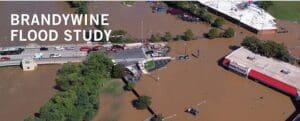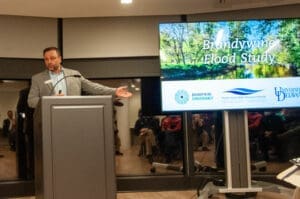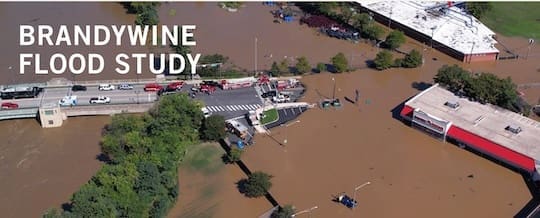
Flooding in Wilmington on Sept. 1, 2021. “What we do upstream impacts downstream,” according to Brandywine Conservancy’s Grant DeCosta. Emergency services couldn’t get from one side of the city to the other, which he called “unacceptable.”
The Brandywine Conservancy and the city of Wilmington joined forces to give area residents an update on the flood study prompted by Hurricane Ida.
Grant DeCosta, director of community services for the conservancy, was joined by Wilmington’s Assistant Water Division Director Bryan Lennon.
DeCosta said Ida was “the catalyst” for the study but that the study won’t be finished until this summer.
He said the goals are to reduce flooding, develop model flood mitigation strategies, coordinate with Delaware’s mitigation efforts, and find “implementable projects.” The entire length of the creek, from its headwaters in Honey Brook in Pennsylvania to Wilmington, is included in the study.
“We are not looking to just write a study,” DeCosta said. “We want to do something that’s going to be a blueprint for all of us to work cooperatively to move forward. There’s going to be implementational recommendations that a whole host of us will be engaged to help us address this problem.”
The conservancy is one of the co-leads in the study. Other groups and organizations in the study include Chester County Water Resources Authority, and the University of Delaware Water Resources Center, among others.
He acknowledged the significance of having the University of Delaware and the City of Wilmington involved.
“I’m happy to have that bi-state reflection of our watershed in those that are helping us do this project,” DeCosta said.
Lennon, who referred to himself as Wilmington’s “sewer guy,” reminded the attendees that the Brandywine is Wilmington’s water source, so helping to protect the water and the health of the creek upstream helps Wilmington, and so the city helps fund projects along the creek in Pennsylvania.
“One dollar spent up in the source water saves us $10 down at our drinking water intake to treat that water,” he said.

Grant DeCosta tells attendees, “We are not looking to just write a study. We want to do something that’s going to be a blueprint for all of us to work cooperatively to move forward.”
In a brief one-on-one interview, Lennon said Ida was a “tremendously impactful storm event,” with thousands of northeast part of Wilmington residents affected when flood waters of the Brandywine ripped through the area on an otherwise sunny day. He said it took about six hours for the flooding in Pennsylvania to reach Wilmington.
“Residents of northeast Wilmington had to be rescued by Wilmington and the state of Delaware emergency management personnel on fireboats,” he said, adding that the damage covered a 10-15 square block area.
Flood study final this summer
While the flood study won’t be final until sometime this summer, Lennon has an idea of what he thinks needs to be done for flood mitigation.
“There was no rainfall happening. It was a beautiful sunny morning, but it was all the water from the upper portion of the watershed. What happened was that those flood waters came down and overtopped the shores of the Brandywine and flooded out the streams, the basements, and the homes of the residents of northeast Wilmington. So, the solution has to be some manner of shoreline protection that can prevent that overtopping of the Brandywine shoreline,” he said.
Flooding from Ida roared through the Brandywine area on Sept. 1, 2021, causing millions of dollars in damage and destroying many homes and other structures from the Downingtown area south through Chadds Ford and down into Wilmington.
Some of those damaged or destroyed buildings, including the popular eatery Hank’s Place in Chadds Ford are still not rebuilt. The Brandywine Conservancy also took a major hit, according to DeCosta, who is also co-director of the conservancy.

Wilmington’s “sewer guy” Bryan Lennon wants flood mitigation efforts to look at keeping the Brandywine from “overtopping” its shoreline.
He noted the irony of not having the meeting in the old meeting room, The River Room, on the lower level of the museum building because the flood ruined that room to the point it had to be decommissioned. They held the Thursday night meeting in a repurposed room that used to be the office of Virginia Logan, the executive director of the Brandywine Conservancy and River Museum of Art.
“We’re trying to make do with what we have. Here we are talking about flooding in a room that’s part of our own recovery from the flood that is still ongoing,” he said, noting that the conservancy has been in the area for 56 years, “We know the challenges the Brandywine has faced over the years.”
IN THE NEWS: Victims’ Rights task force to hear updating, funding ideas
He said the conservancy has incurred more than $10 million in damage and 10 of its buildings were damaged to one degree or another. (The conservancy received approval to demolish several of them.)
Residents who want to keep tabs on the study and even take part, are encouraged to take a public input survey here. There is also a public input web map here where people can submit non-emergency concerns about flooding.
DeCosta said the study partners are working to have a similar meeting in Delaware.
Share this Post




